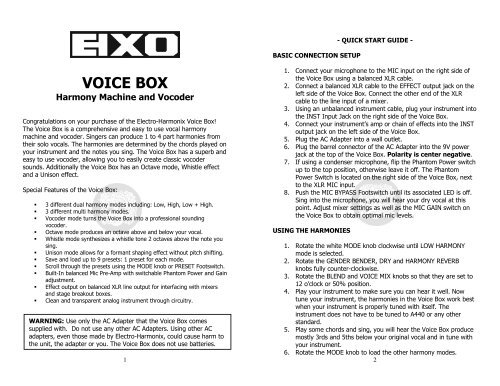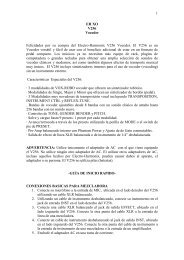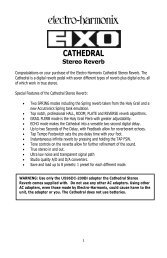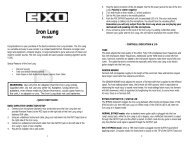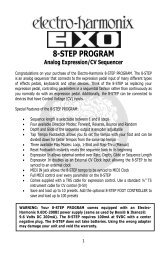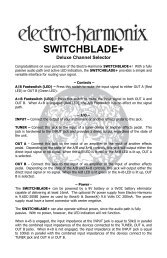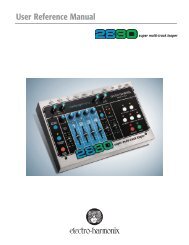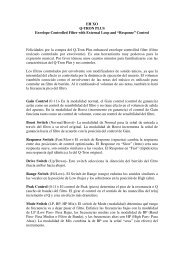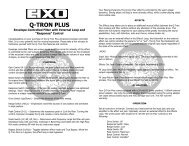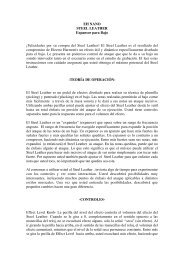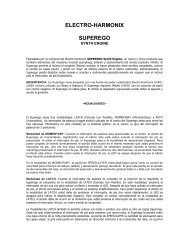VOICE BOX - Electro-Harmonix
VOICE BOX - Electro-Harmonix
VOICE BOX - Electro-Harmonix
You also want an ePaper? Increase the reach of your titles
YUMPU automatically turns print PDFs into web optimized ePapers that Google loves.
<strong>VOICE</strong> <strong>BOX</strong><br />
Harmony Machine and Vocoder<br />
Congratulations on your purchase of the <strong>Electro</strong>-<strong>Harmonix</strong> Voice Box!<br />
The Voice Box is a comprehensive and easy to use vocal harmony<br />
machine and vocoder. Singers can produce 1 to 4 part harmonies from<br />
their solo vocals. The harmonies are determined by the chords played on<br />
your instrument and the notes you sing. The Voice Box has a superb and<br />
easy to use vocoder, allowing you to easily create classic vocoder<br />
sounds. Additionally the Voice Box has an Octave mode, Whistle effect<br />
and a Unison effect.<br />
Special Features of the Voice Box:<br />
� 3 different dual harmony modes including: Low, High, Low + High.<br />
� 3 different multi harmony modes.<br />
� Vocoder mode turns the Voice Box into a professional sounding<br />
vocoder.<br />
� Octave mode produces an octave above and below your vocal.<br />
� Whistle mode synthesizes a whistle tone 2 octaves above the note you<br />
sing.<br />
� Unison mode allows for a formant shaping effect without pitch shifting.<br />
� Save and load up to 9 presets: 1 preset for each mode.<br />
� Scroll through the presets using the MODE knob or PRESET Footswitch.<br />
� Built-In balanced Mic Pre-Amp with switchable Phantom Power and Gain<br />
adjustment.<br />
� Effect output on balanced XLR line output for interfacing with mixers<br />
and stage breakout boxes.<br />
� Clean and transparent analog instrument through circuitry.<br />
WARNING: Use only the AC Adapter that the Voice Box comes<br />
supplied with. Do not use any other AC Adapters. Using other AC<br />
adapters, even those made by <strong>Electro</strong>-<strong>Harmonix</strong>, could cause harm to<br />
the unit, the adapter or you. The Voice Box does not use batteries.<br />
1<br />
BASIC CONNECTION SETUP<br />
- QUICK START GUIDE -<br />
1. Connect your microphone to the MIC input on the right side of<br />
the Voice Box using a balanced XLR cable.<br />
2. Connect a balanced XLR cable to the EFFECT output jack on the<br />
left side of the Voice Box. Connect the other end of the XLR<br />
cable to the line input of a mixer.<br />
3. Using an unbalanced instrument cable, plug your instrument into<br />
the INST Input Jack on the right side of the Voice Box.<br />
4. Connect your instrument’s amp or chain of effects into the INST<br />
output jack on the left side of the Voice Box.<br />
5. Plug the AC Adapter into a wall outlet.<br />
6. Plug the barrel connector of the AC Adapter into the 9V power<br />
jack at the top of the Voice Box. Polarity is center negative.<br />
7. If using a condenser microphone, flip the Phantom Power switch<br />
up to the top position, otherwise leave it off. The Phantom<br />
Power Switch is located on the right side of the Voice Box, next<br />
to the XLR MIC input.<br />
8. Push the MIC BYPASS Footswitch until its associated LED is off.<br />
Sing into the microphone, you will hear your dry vocal at this<br />
point. Adjust mixer settings as well as the MIC GAIN switch on<br />
the Voice Box to obtain optimal mic levels.<br />
USING THE HARMONIES<br />
1. Rotate the white MODE knob clockwise until LOW HARMONY<br />
mode is selected.<br />
2. Rotate the GENDER BENDER, DRY and HARMONY REVERB<br />
knobs fully counter-clockwise.<br />
3. Rotate the BLEND and <strong>VOICE</strong> MIX knobs so that they are set to<br />
12 o’clock or 50% position.<br />
4. Play your instrument to make sure you can hear it well. Now<br />
tune your instrument, the harmonies in the Voice Box work best<br />
when your instrument is properly tuned with itself. The<br />
instrument does not have to be tuned to A440 or any other<br />
standard.<br />
5. Play some chords and sing, you will hear the Voice Box produce<br />
mostly 3rds and 5ths below your original vocal and in tune with<br />
your instrument.<br />
6. Rotate the MODE knob to load the other harmony modes.<br />
2
<strong>VOICE</strong> MIX Knob Adjustments<br />
7. When the Voice Box is set to one of the 6 harmony modes, the<br />
<strong>VOICE</strong> MIX knob adjusts the mix between lower and higher<br />
harmonies. For example, when the Voice Box is set to LOW<br />
HARMONY mode, the <strong>VOICE</strong> MIX knob will mix between the 3rd<br />
below your original note and the 5th below your original note.<br />
8. Adjust the <strong>VOICE</strong> MIX knob to hear the mix of lower 3rd and<br />
lower 5th harmonies you like best.<br />
GENDER BENDER Knob Adjustments<br />
9. In the 6 harmony modes, the GENDER BENDER knob controls<br />
the timbre of the harmony voices. As you turn the GENDER<br />
BENDER knob clockwise, the formant of the harmony voices<br />
shifts upward or downward. The direction of the formant shift<br />
depends on the harmony mode selected.<br />
10. As an example, if the Voice Box is set to LOW HARMONY mode,<br />
as you turn the GENDER BENDER knob clockwise, the formant<br />
shifts downward, emulating the lengthening of the vocal tract.<br />
Male singers tend to have longer vocal tracts than female<br />
singers, so by turning the GENDER BENDER knob clockwise in<br />
LOW HARMONY mode, you are making the harmony voices<br />
sound more male.<br />
11. Turning the GENDER BENDER knob counter-clockwise reduces<br />
the formant shift, going all the way down to zero when set fully<br />
counter-clockwise.<br />
Adding Reverb<br />
12. The Voice Box includes separate control for DRY or HARMONY<br />
reverb.<br />
13. Turn up the HARMONY knob under REVERB and you will hear<br />
the harmony voices going through the reverb effect.<br />
14. Turn up the DRY knob under REVERB and you will hear your dry<br />
vocals going through the reverb effect.<br />
15. You can apply separate amounts of reverb to your effected<br />
vocals or dry vocals.<br />
3<br />
USING THE VOCODER<br />
1. Turn the MODE knob counter-clockwise until VOCODER mode is<br />
selected.<br />
2. Rotate DRY REVERB, HARMONY REVERB and <strong>VOICE</strong> MIX knobs<br />
fully counter-clockwise.<br />
3. Rotate the GENDER BENDER knob to 12 o’clock or 50%.<br />
4. Rotate the BLEND fully clockwise so all you hear is effect.<br />
5. You may even want to mute the output of the instrument signal,<br />
for example turn off your guitar amp if using an amp.<br />
6. Play a chord on your instrument then sing something. You<br />
should hear your voice modulating the instrument. You are now<br />
vocoding.<br />
7. Try turning the <strong>VOICE</strong> MIX knob up to 50%. In VOCODER mode,<br />
the <strong>VOICE</strong> MIX knob gives a treble boost up 12 o’clock. Past 12<br />
o’clock, it will add more harmonics to your instrument,<br />
emphasizing the most sibilant frequency ranges of the voice.<br />
This makes it easier to obtain vocoded sounds out of dry guitar.<br />
8. In VOCODER mode, the GENDER BENDER knob again shifts the<br />
formant. Above 12 o’clock, the formant will shift upward (more<br />
female). Below 12 o’clock, the formant shifts downward (more<br />
male). At 12 o’clock there is no formant shift.<br />
9. The BLEND knob can be used to mix in some of your dry vocal<br />
to create interesting doubled vocal effects.<br />
10. You can add some reverb to the vocoded signal by turning up<br />
the HARMONY REVERB knob.<br />
USING OCTAVES MODE<br />
1. OCTAVES mode does not require an instrument to be played in<br />
order for it to produce the octaves above and below your<br />
original vocals.<br />
2. Turn the MODE knob until OCTAVES mode is selected.<br />
3. The <strong>VOICE</strong> MIX knob mixes between the lower and upper<br />
octaves. Full counter-clockwise produces the lower octave and<br />
full clockwise produces the upper octave. 12 o’clock on the<br />
<strong>VOICE</strong> MIX knob will produce an equal mix of both octaves.<br />
4. Turning GENDER BENDER clockwise in OCTAVES mode increases<br />
the amount formant shift for both the upper and lower octave.<br />
GENDER BENDER shifts the formant upward for the upper<br />
octave and shifts it downward for the lower octave. Turning the<br />
GENDER BENDER knob counter-clockwise will reduce the<br />
formant shift to zero at the minimum position.<br />
4
USING UNISON + WHISTLE MODE<br />
1. UNISON + WHISTLE mode is another mode that does not<br />
require an instrument to be played for it to work properly.<br />
UNISON is vocal formant shift effect with no pitch shifting and<br />
WHISTLE synthesizes a whistle tone two octaves above the note<br />
you sing.<br />
2. Turn the MODE knob until UNISON + WHISTLE mode is<br />
selected.<br />
3. The <strong>VOICE</strong> MIX knob mixes between the UNISON effect (fully<br />
counter-clockwise) and the WHISTLE effect (fully clockwise).<br />
4. The GENDER BENDER knob sets the amount of formant shifting<br />
for UNISON mode. Above 12 o’clock, the formant will shift<br />
upward (more female). Below 12 o’clock, the formant shifts<br />
downward (more male). At 12 o’clock there is no formant shift.<br />
5<br />
- DESCRIPTION OF MODES -<br />
The Voice Box has 9 modes to choose from. Each mode gives the musician a different<br />
sonic palette to work with. In addition, each mode may change the functionality of<br />
some of the Voice Box’s knobs. In this section we will describe each mode and the<br />
functionality of the knobs that change with the mode.<br />
Use the MODE knob to cycle through the modes. Turning the MODE knob clockwise<br />
goes up the LED ladder. Turning the MODE knob counter-clockwise goes down the<br />
LED ladder.<br />
Below is a table displaying the function of each knob as it relates to the selected<br />
mode. Arrows indicate the function that occurs as the knob is turned to or towards<br />
the extreme knob position in that direction. You will notice some knobs, such as<br />
BLEND, do not change with the mode while others, such as GENDER BENDER, are the<br />
same basic control but the direction or amount of the function changes for nearly<br />
every mode.<br />
6
HARMONY Modes<br />
The six HARMONY Modes will pitch shift your voice to create 2 to 4 part<br />
harmonies along with your dry vocal. The pitch and number of<br />
harmonies depends on the selected mode. In addition the exact function<br />
of the <strong>VOICE</strong> MIX and GENDER BENDER knobs changes slightly with<br />
each mode. Please Note: All six harmony modes require an instrument<br />
to be played along with your vocal to provide the key information for the<br />
pitch shifter. If no instrument is plugged in and playing, the six harmony<br />
modes will not work correctly. The Voice Box works best with full<br />
chords; for example a chord with at least the root, 3rd and 5th.<br />
LOW HARMONY<br />
The Voice Box creates two harmony voices below the note you sing. The<br />
low voice is usually the lower 3rd below your note but will sometimes be<br />
the lower 4th depending on the most appropriate harmony for the chord<br />
your instrument plays and the note you sing. The high voice is usually<br />
the lower 5th below the note you sing but will sometimes be the lower<br />
6th again depending on which harmony is the most appropriate.<br />
<strong>VOICE</strong> MIX knob: Mixes between the lower 3rd harmony (in<br />
knob’s LOW position) and the lower 5th harmony (in knob’s<br />
HIGH position). When set to 12 o’clock, there will be an equal<br />
mix of both harmonies.<br />
GENDER BENDER knob: As turned clockwise, GENDER<br />
BENDER shifts the formant downward, making the harmonies<br />
sound more male. When turned fully counter-clockwise, there is<br />
no formant shift.<br />
HIGH HARMONY<br />
The Voice Box creates two harmony voices above the note you sing. The<br />
low voice is usually the 3rd above your note but will sometimes be the<br />
4th depending on the most appropriate harmony for the chord your<br />
instrument plays and the note you sing. The high voice is usually the 5th<br />
above the note you sing but will sometimes be the 6th again depending<br />
on the most appropriate harmony.<br />
<strong>VOICE</strong> MIX knob: Mixes between the 3rd harmony (in knob’s<br />
LOW position) and the 5th harmony (in knob’s HIGH position).<br />
When set to 12 o’clock, there will be an equal mix of both<br />
harmonies.<br />
7<br />
GENDER BENDER knob: As turned clockwise, GENDER<br />
BENDER shifts the formant upward, making the harmony sound<br />
more female. When turned fully counter-clockwise, there is no<br />
formant shift.<br />
LOW + HIGH HARMONY<br />
The Voice Box creates two harmony voices one above the note you sing<br />
and one below. The low voice is usually the lower 5th below the note<br />
you sing. The high voice is usually the upper 3rd above the note you<br />
sing.<br />
<strong>VOICE</strong> MIX knob: Mixes between the lower 5th harmony (in<br />
knob’s LOW position) and the upper 3rd harmony (in knob’s<br />
HIGH position). When set to 12 o’clock, there will be an equal<br />
mix of both harmonies.<br />
GENDER BENDER knob: For the lower harmony, GENDER<br />
BENDER shifts the formant downward, making the harmony<br />
sound more male. For the upper harmony, the formant shifts<br />
upward, making the harmony<br />
sound more female. When turned fully counter-clockwise, there<br />
is no formant shift.<br />
MULTI HARMONY 1: Lower 3rd, Lower 5th and Upper 3rd<br />
The Voice Box creates three harmonies: two lower harmonies and<br />
one upper harmony. The harmonies consist of the lower 3rd harmony,<br />
the lower 5th harmony and the upper 3rd harmony.<br />
<strong>VOICE</strong> MIX knob: Mixes between the lower 3rd harmony (in<br />
knob’s LOW position) and the upper 3rd harmony (in knob’s<br />
HIGH position). The volume of the lower 5th harmony does not<br />
change with the <strong>VOICE</strong> MIX knob. When set to 12 o’clock, there<br />
is an equal mix of all harmonies.<br />
GENDER BENDER knob: For the lower harmonies, GENDER<br />
BENDER shifts the formant downward, making the harmonies<br />
sound more male. For the upper harmony the formant shifts<br />
upward, making the harmony sound more female. When turned<br />
fully counter-clockwise, there is no formant shift.<br />
8
MULTI HARMONY 2: Lower 3rd, Lower 5th, Upper 3rd and Upper Octave<br />
The Voice Box creates the same three harmonies as in Multi Harmony 1<br />
and adds the upper octave. The harmonies consist of the lower 3rd<br />
harmony, the lower 5th harmony and the upper 3rd harmony. Added to<br />
the mix is the upper octave.<br />
<strong>VOICE</strong> MIX knob: Mixes between the lower 3rd harmony (in<br />
knob’s LOW position) and the upper octave (in knob’s HIGH<br />
position). The levels of the lower 5th harmony and upper 3rd<br />
harmony do not change with the <strong>VOICE</strong> MIX knob. When set to<br />
12 o’clock, there will be an equal mix of all harmonies and upper<br />
octave.<br />
GENDER BENDER knob: For the lower harmonies, GENDER<br />
BENDER shifts the formant downward, making the harmonies<br />
sound more male. For the upper harmony and octave, the<br />
formant shifts upward, making the harmonies sound more<br />
female. When turned fully counter-clockwise, there is no formant<br />
shift.<br />
MULTI HARMONY 3: Lower Octave, Lower 5th, Upper 3rd and Upper 5th<br />
The Voice Box creates three harmonies (one below, two above) plus an<br />
octave down. The harmonies consist of the lower 5th harmony, the<br />
upper 3rd harmony and the upper 5th harmony. Added to the mix is the<br />
lower octave.<br />
<strong>VOICE</strong> MIX knob: Mixes between the lower octave (in knob’s<br />
LOW position) and the upper 5th harmony (in knob’s HIGH<br />
position). The levels of the lower 5th harmony and upper 3rd<br />
harmony do not change<br />
with the <strong>VOICE</strong> MIX knob. When set to 12 o’clock, there will be<br />
an equal mix of all harmonies and lower octave.<br />
GENDER BENDER knob: For the lower harmony and octave,<br />
GENDER BENDER shifts the formant downward, making the<br />
harmonies sound more male. For the upper harmonies, the<br />
formant shifts upward, making the harmonies sound more<br />
female. When turned fully counter-clockwise, there is no formant<br />
shift.<br />
9<br />
OCTAVES Mode<br />
OCTAVES mode pitch shifts your vocal up and down exactly one octave.<br />
Since the amount of pitch shift is preset to an octave, this mode does<br />
not require an instrument to be played along with your vocal.<br />
<strong>VOICE</strong> MIX knob: Mixes between the lower octave (in knob’s<br />
LOW position) and the upper octave (in knob’s HIGH position).<br />
When set to 12 o’clock, there will be an equal mix of the two<br />
octaves.<br />
GENDER BENDER knob: For the lower octave, turning<br />
GENDER BENDER clockwise shifts the formant downward,<br />
making the lower octave sound more male. For the upper<br />
octave, turning GENDER BENDER clockwise shifts the formant<br />
upward, making the upper octave sound more female. When<br />
turned fully counter-clockwise, there is no formant shift.<br />
UNISON + WHISTLE Mode<br />
UNISON + WHISTLE mode is really like having two modes in one. Each<br />
function is separate from the other. UNISON mode allows for formant<br />
shift without changing the pitch of your vocal. For example, you want to<br />
sound more womanly but without changing your pitch. WHISTLE mode<br />
synthesizes a whistle tone exactly two octaves above the note you sing.<br />
<strong>VOICE</strong> MIX knob: Mixes between the UNISON effect (in knob’s<br />
LOW position) and the WHISTLE effect (in knob’s HIGH<br />
position). When set to 12 o’clock, there will be an equal mix of<br />
UNISON and WHISTLE.<br />
GENDER BENDER knob: Adjusts formant shift for the UNISON<br />
effect only. When GENDER BENDER is set to 12 o’clock, there is<br />
no formant shift. As you turn the knob clockwise from 12 o’clock,<br />
the formant shifts upward for a more female sounding vocal. As<br />
you turn the knob counter-<br />
clockwise from 12 o’clock, the formant shifts downward for a<br />
more male sounding vocal.<br />
10
VOCODER Mode<br />
VOCODER mode turns the Voice Box into a 256 Band vocoder. Vocoding<br />
is an effect that allows a voice to modulate an instrument or sound<br />
source. The controls have been optimized so that the vocoder is very<br />
much plug, play and sing; the musician does not need to do much work<br />
to create fantastic sounding vocoder effects. As with most vocoders,<br />
both a vocal signal and an instrument signal are required to obtain the<br />
proper effect.<br />
<strong>VOICE</strong> MIX knob: In Vocoder mode, the <strong>VOICE</strong> MIX knob<br />
increases treble response and articulation. As you turn the knob<br />
up from fully counter-clockwise to 12 o’clock, the treble will be<br />
increasingly boosted. Turning the <strong>VOICE</strong> MIX knob further past<br />
12 o’clock no longer increases the treble but puts the instrument<br />
signal through octave harmonic enhancement. The increased<br />
harmonic content gives the vocoder more frequencies to work<br />
with in the vocals fricative and sibilant range. This is especially<br />
useful with a clean guitar signal.<br />
GENDER BENDER knob: When GENDER BENDER is set to 12<br />
o’clock, there is no formant shift. As you turn the knob clockwise<br />
from 12 o’clock, the formant shifts upward for a more female<br />
sounding vocoder effect. As you turn the knob counter-clockwise<br />
from 12 o’clock, the formant shifts downward for a more male<br />
sounding vocoder effect.<br />
- PRESETS -<br />
The Voice Box can save one preset for each of the 9 modes. Each preset<br />
will pertain directly to the mode you have saved it in. Once a preset is<br />
saved, the Voice Box will remember the preset after power has been<br />
disconnected.<br />
Saving a preset will save the setting of all 5 of the black knobs. It will<br />
not save the state of the MIC BYPASS Footswitch, the MIC GAIN Toggle<br />
switch or the PHANTOM POWER Toggle switch.<br />
PRESET SAVE PROCEDURE:<br />
1. To Save the knob positions that are currently set up, press and<br />
hold down the MODE knob.<br />
11<br />
2. Hold down MODE for 3 seconds. Nothing will occur for 2<br />
seconds, then all the mode LEDs will blink for 1 second.<br />
3. After the LEDs stop blinking, let go of the MODE knob. The<br />
PRESET LED will light up solid. The PRESET LED is located to the<br />
left of the PRESET FOOTSWITCH.<br />
4. Your preset has been saved in the mode that is currently lit.<br />
PRESET LOAD PROCEDURE:<br />
USING MODE KNOB<br />
1. To Load a preset you previously saved: turn the MODE knob to<br />
the mode where the preset was saved.<br />
2. Press and release the MODE knob. The PRESET LED will light up<br />
to indicate that the Preset has loaded. Please Note: The current<br />
knob positions are no longer valid.<br />
USING PRESET FOOTSWITCH<br />
1. To Load a preset you previously saved using the PRESET<br />
Footswitch: press and release the PRESET Footswitch. The<br />
PRESET LED will light up to indicate that the Preset has loaded<br />
for the currently selected mode. Please Note: The current knob<br />
positions are no longer valid.<br />
2. If you press and release the PRESET Footswitch while a preset is<br />
already loaded into the current mode, the Voice Box will jump<br />
down to the next mode and load its preset. For example, if you<br />
have a preset loaded into HIGH HARMONY mode, then press the<br />
PRESET Footswitch, the Voice Box will then select LOW + HIGH<br />
as its current mode, then load its preset.<br />
After loading a preset, if you move a knob, the knob’s new location will<br />
supersede the preset’s stored value for that knob. At this point, the<br />
PRESET LED will blink rapidly to indicate that a knob has been moved. If<br />
you then turn the knob back to its position, as saved in the preset, the<br />
PRESET LED will stop blinking.<br />
If the PRESET LED is blinking rapidly, when you press the PRESET<br />
Footswitch, it will re-load the preset for whichever mode you are<br />
currently in.<br />
PRESET UNLOAD PROCEDURE:<br />
A preset can be unloaded to restore the current knob positions so they<br />
represent what you hear. There are two ways to unload a preset, press<br />
and release the MODE knob or turn the MODE knob to another mode.<br />
12
- CONTROLS, INDICATORS & I/O-<br />
The following descriptions detail all of the knobs, switches, LEDs (lights)<br />
and I/O jacks on the Voice Box:<br />
MODE KNOB<br />
This is the white knob located in the upper right corner of your Voice<br />
Box. The MODE knob is a rotary encoder enabling the user to scroll<br />
through the 9 Modes of the Voice Box. Turn the knob clockwise to<br />
progress up through the modes: from VOCODER to LOW HARMONY<br />
mode. Turn the knob counter-clockwise to progress down through the<br />
modes: from LOW HARMONY to VOCODER mode.<br />
The MODE knob also has a push switch to save and load presets. To<br />
load a preset: turn the MODE knob to select the desired mode and then<br />
give the MODE knob a quick tap. To save a preset: push down and hold<br />
the MODE knob for 3 seconds. You will then see all mode LEDs blink<br />
rapidly. Continue to hold down the MODE knob until the LEDs stop<br />
blinking. At this point the preset is saved and you can let go of the knob.<br />
Only one preset is saved per mode and the preset you save is based on<br />
the selected mode.<br />
Please note: The six harmony modes require an instrument to play<br />
chords along with the vocals so that the Voice Box can determine the<br />
key of your song. VOCODER mode also requires an instrument or sound<br />
source. Neither OCTAVES or UNISON + WHISTLE modes require an<br />
instrument or sound source.<br />
GENDER BENDER KNOB<br />
Formant shift corresponds roughly to the length of the vocal tract. Bass<br />
and baritone singers have longer vocal tracts than sopranos and tenors.<br />
In all modes, the GENDER BENDER knob adjusts the amount of formant<br />
shift that is applied to the harmony, octave or effected voices. For voices<br />
that are pitch shifted up, the formant will shift upward, which is<br />
equivalent to shortening the vocal tract, to sound more female. For<br />
voices that are pitch shifted down, the formant will shift downward,<br />
which is equivalent to lengthening the vocal tract, to sound more male.<br />
In all modes except UNISON and VOCODER, turning the GENDER<br />
BENDER knob clockwise will increase the amount of formant shift from<br />
13<br />
zero to 100%. In UNISON and VOCODER mode, zero formant shift is at<br />
the center of the knob’s range, or 12 o’clock. Turning GENDER BENDER<br />
clockwise from 12 o’clock will shift the formant upward, or shorten the<br />
vocal tract. Turning GENDER BENDER counter-clockwise from 12 o’clock<br />
will shift the formant downward, or lengthen the vocal tract.<br />
<strong>VOICE</strong> MIX KNOB<br />
In all modes, the <strong>VOICE</strong> MIX knob mixes between two different voices.<br />
In most cases it mixes between a low harmony voice (counter-clockwise<br />
position) and a high harmony voice (clockwise position). The following<br />
table lists the <strong>VOICE</strong> MIX’s range for each mode:<br />
MODE <strong>VOICE</strong> MIX RANGE<br />
LOW to HIGH knob position<br />
LOW HARMONY Lower 3rd to Lower 5th<br />
HIGH HARMONY Upper 3rd to Upper 5th<br />
LOW + HIGH Lower 5th to Upper 3rd<br />
MULTI HARMONY 1 Lower 5th to Upper 3rd<br />
MULTI HARMONY 2 Lower 5th to Upper Octave<br />
MULTI HARMONY 3 Lower Octave to Upper 5th<br />
OCTAVES Lower Octave to Upper Octave<br />
UNISON + WHISTLE Unison to Whistle<br />
VOCODER Bass to Treble to Enhanced Harmonics<br />
REVERB KNOBs<br />
DRY REVERB Knob: This is a volume control for the reverb that is<br />
applied to the Dry vocals.<br />
HARMONY REVERB Knob: This is a volume control for the reverb that<br />
is applied to the effected vocals. You can add reverb to all of the effects,<br />
not just harmony voices. For example, while using the WHISTLE effect,<br />
turning up the HARMONY REVERB knob will apply reverb to the<br />
WHISTLE effect.<br />
14
BLEND KNOB<br />
The BLEND knob is a wet/dry control for the effect output jack. Turning<br />
the BLEND knob to its minimum counter-clockwise position will yield<br />
100% dry and no wet signal. Turning the BLEND knob to its maximum<br />
clockwise position will give you 100% wet and no dry signal. To obtain<br />
an equal balance of both wet and dry signals, set the BLEND control to<br />
50%.<br />
PRESET Footswitch / LED<br />
Press and release the PRESET Footswitch to load a preset into the<br />
presently selected mode. If a preset is already loaded into the presently<br />
selected preset, pressing the PRESET Footswitch will select the next<br />
mode and load its preset.<br />
The PRESET LED will light solid when a preset is loaded. While a preset<br />
is loaded, if a black knob is turned, the PRESET LED will blink rapidly<br />
telling you that though a preset is loaded, one or more knobs have been<br />
turned. Pressing the PRESET Footswitch while the PRESET LED is<br />
blinking will re-load the preset for the current mode.<br />
MIC BYPASS Footswitch / STATUS LED<br />
The Bypass footswitch toggles the Voice Box between effect mode and<br />
bypass mode. If the STATUS LED is lit, then the Voice Box is in effect<br />
mode. If the STATUS LED is off, then the Voice Box is in bypass mode.<br />
In bypass mode: the dry vocal is output through the EFFECT Output<br />
XLR jack and the effect is muted. In effect mode: the output of the<br />
BLEND control determines how much effect vs. dry signal is output<br />
through the EFFECT Output XLR jack.<br />
In both effect and bypass modes, the instrument’s signal goes through a<br />
high quality buffer stage between the INSTRUMENT INPUT and OUTPUT<br />
jacks.<br />
MIC GAIN Toggle Switch<br />
Use this switch to change the sensitivity of the mic pre-amp in the Voice<br />
Box. HI gain mode should be used in most situations. LO mode is useful<br />
if HI mode is clipping, if you want to connect the output from another<br />
15<br />
mic pre-amp to the input of the Voice Box or if you have a loud singer<br />
with an especially sensitive microphone.<br />
PHANTOM POWER Toggle Switch<br />
On the side of the Voice Box, next to the MIC INPUT XLR jack, is the<br />
PHANTOM POWER toggle switch. Pushing the toggle switch up will<br />
supply +45V to the microphone. The PHANTOM POWER switch should<br />
only be set to ON when using a condenser microphone.<br />
MIC INPUT XLR Jack<br />
The MIC INPUT XLR jack is a fully balanced microphone input. Connect<br />
your microphone directly to this input jack. The input impedance at the<br />
MIC INPUT XLR jack is 10 kΩ.<br />
INSTRUMENT INPUT ¼” Jack<br />
In all modes but two (OCTAVES and UNISON + WHISTLE), the Voice<br />
Box requires an instrument to be played along with your vocals. For the<br />
six harmony modes, the Voice Box needs an instrument to provide<br />
chords so that the Voice Box can determine the key of your instrument.<br />
The best types of chords for the Voice Box should include the root, 3rd<br />
and 5th of the chord. VOCODER mode only requires a sound source; the<br />
VOCODER effects the instrument you play with your voice.<br />
Plug the output of your instrEmail us at info@ehx.com<br />
ument into the INSTRUMENT INPUT jack. The input impedance<br />
presented at the INSTRUMENT INPUT XLR jack is 2.2 MΩ.<br />
EFFECT OUTPUT XLR Jack<br />
The Voice Box’s vocal effect is output through the EFFECT OUTPUT XLR<br />
jack on the side of the unit. The vocal harmonies, vocoder and other<br />
effects as well as the dry and bypassed vocals are output from this jack.<br />
The EFFECT OUTPUT XLR jack is a fully balanced line output jack. It can<br />
be connected directly to the line input of a mixer, on stage breakout<br />
boxes or the input of an A/D converter. The output impedance is 700 Ω.<br />
16
INSTRUMENT OUTPUT ¼” Jack<br />
Connect this output to your amp, effects or other device. The output<br />
impedance is 700 Ω.<br />
9V Power Jack<br />
Plug the output of the Voice Box’s supplied AC Adapter into the 9V<br />
power jack located at the top of the Voice Box. The Voice Box requires 9<br />
- 9.6VDC at 200mA with a center negative plug. The Voice Box accepts<br />
Boss style AC Adapters.<br />
TECHNICAL SPECIFICATIONS<br />
Mic Pre-Amp Gain:<br />
LO Mode = 15db; HI Mode = 25dB (XLR out into High Z load)<br />
LO Mode = 4.5dB; HI Mode = 15dB (XLR out into 600 Ω load)<br />
A/D and D/A Conversion Sample Rate = 36 kHz<br />
A/D and D/A Conversion Bit Resolution = 24 bits<br />
17


